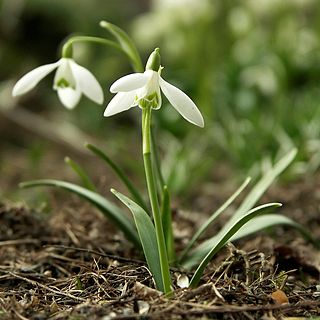
Galanthus, or snowdrop, is a small genus of approximately 20 species of bulbous perennial herbaceous plants in the family Amaryllidaceae. The plants have two linear leaves and a single small white drooping bell-shaped flower with six petal-like (petaloid) tepals in two circles (whorls). The smaller inner petals have green markings.

Pamianthe is a genus of South American bulbous perennials in the Amaryllis family, subfamily Amaryllidoideae. They can be found in sandy, but rocky areas in Colombia, Ecuador, Peru, and Bolivia.
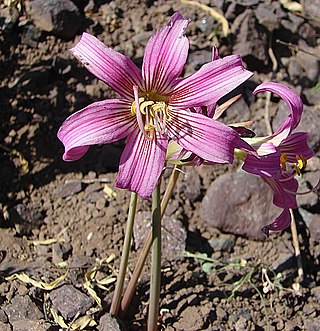
Rhodolirium is a small South American genus in the tribe Hippeastreae of the family Amaryllidaceae. Although originally described by Philippi in 1858 it has long remained buried in other taxa, principally Hippeastrum and more recently Rhodophiala. Only in recent years has it been rehabilitated.
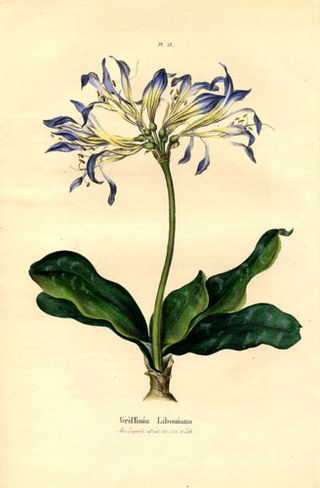
The Griffineae is a tribe in the family Amaryllidaceae, subfamily Amaryllidoideae. It includes 3 genera with 22 species endemic to Brazil in South America. A typical character of the representatives of the tribe are the flowers - They are blue or lilac and collected into an umbel. Only the members of this tribe and the genus Lycoris are able to form flowers with such color in the whole subfamily Amaryllidoideae of Amaryllidaceae. The species in this group are typically perennial and produce bulbs. The leaves are green, with elliptical form in most of the cases but in some members, as in Worsleya, they are sword-shaped.

Urceolina amazonica, formerly known as Eucharis amazonica, is a species of flowering plant in the family Amaryllidaceae, native to Peru. It is cultivated as an ornamental in many countries and naturalized in Venezuela, Mexico, the West Indies, Ascension Island, Sri Lanka, Fiji, the Solomon Islands and the Society Islands. The English name Amazon lily is used for this species, but is also used for some other species of the genus Urceolina.
Alan W. Meerow is an American botanist, born in New York City in 1952. He specializes in the taxonomy of the family Amaryllidaceae and the horticulture of palms and tropical ornamental plants. He also works on the population genetics and molecular systematics of cycads and palms.
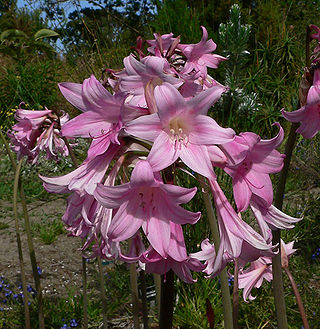
The Amaryllidaceae are a family of herbaceous, mainly perennial and bulbous flowering plants in the monocot order Asparagales. The family takes its name from the genus Amaryllis and is commonly known as the amaryllis family. The leaves are usually linear, and the flowers are usually bisexual and symmetrical, arranged in umbels on the stem. The petals and sepals are undifferentiated as tepals, which may be fused at the base into a floral tube. Some also display a corona. Allyl sulfide compounds produce the characteristic odour of the onion subfamily (Allioideae).

Stenomesson is a genus of bulbous plants in the family Amaryllidaceae. All the species are native to western South America.
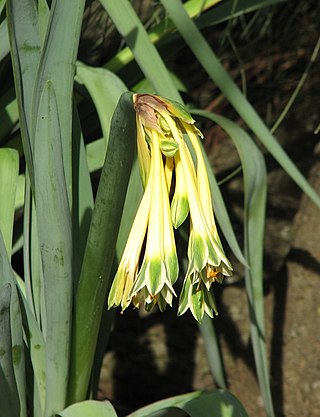
Clinanthus is a genus of bulbous plants in the family Amaryllidaceae. It is found in western South America, including Ecuador, Peru, Bolivia, north Chile and north west Argentina.

Amaryllidoideae is a subfamily of monocot flowering plants in the family Amaryllidaceae, order Asparagales. The most recent APG classification, APG III, takes a broad view of the Amaryllidaceae, which then has three subfamilies, one of which is Amaryllidoideae, and the others are Allioideae and Agapanthoideae. The subfamily consists of about seventy genera, with over eight hundred species, and a worldwide distribution.

Hippeastrinae is a subtribe of plants classified under the tribe Hippeastreae. It belongs to the subfamily Amaryllidoideae of the Amaryllis family (Amaryllidaceae).

Phycella is a genus of herbaceous, perennial bulbous flowering plants belonging to the family Amaryllidaceae, subfamily Amaryllidoideae. The genus consists of five species distributed from central Chile to northwestern Argentina.

Traubiinae is a subtribe of plants classified under the tribe Hippeastreae. It belongs to the subfamily Amaryllidoideae of the Amaryllis family (Amaryllidaceae).

Eustephieae is a flowering plant tribe in the family Amaryllidaceae, subfamily Amaryllidoideae. It forms part of the Andean clade, one of two clades in The Americas.
Stenomesseae was a tribe, where it forms part of the Andean clade, one of two American clades. The tribe was originally described by Traub in his monograph on the Amaryllidaceae in 1963, as Stenomessae based on the type genus Stenomesson. In 1995 it was recognised that Eustephieae was a distinct group separate from the other Stenomesseae. Subsequently, the Müller-Doblies' (1996) divided tribe Eustephieae into two subtribes, Stenomessinae and Eustephiinae.

Eucharideae is a tribe of plants within the family Amaryllidaceae. It was augmented in 2000 by Meerow et al. following a molecular phylogenetic study that revealed that many elements of the tribe Stenomesseae segregated with it, rather than separately, and were subsequently submerged in it. Further revisions were made in 2020, when three genera were merged. It forms one of the tribes of the Andean subclade of the American clade of the subfamily.

Clinantheae is a tribe, where it forms part of the Andean clade, one of two American clades. The tribe was described in 2000 by Alan Meerow et al. as a result of a molecular phylogenetic study of the American Amaryllidoideae. This demonstrated that the tribe Stenomesseae, including the type genus Stenomesson was polyphyletic. Part of the tribe segregated with the Eucharideae and were submerged into it, while the other part formed a unique subclade. Since the type species of Stenomesson was not part of the second subclade, it was necessary to form a new name for the remaining species together with the other genera that remained. This was Clinanthus, the oldest name for these species, and consequently the tribe Clinantheae.
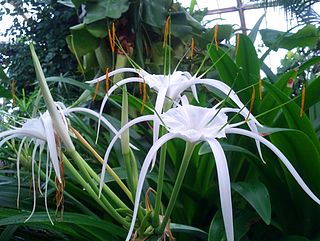
Hymenocallideae is a tribe, where it forms part of the Andean clade, one of two American clades. The tribe was originally recognised by both Meerow (1995) and the Muller-Doblies' (1996). Its phylogenetic position within the Amaryllidoideae was established by Meerow et al. in 2000, while in-depth infratribal relationships were established in 2002.
Stenomesson chloranthum is a species of flowering plant in the amaryllis family, Amaryllidaceae. It is endemic to Peru. Alan Meerow and Henk van der Werff the botanists who first formally described the species, named it after its green flowers.

Stenomesson leucanthum is a species of flowering plant in the family Amaryllidaceae. It is native to Peru. Pierfelice Ravenna, the Chilean botanists who first formally described the species, using the basionym Pucara leucantha, named it after its white flowers.















